Fisker appears set for liquidation, potentially serving as the final nail in the coffin for the car manufacturer that filed for bankruptcy at the start of last week.
In its bankruptcy filing, Fisker claimed it was seeking additional financing and planned to continue “reduced operations.” However, while speaking at a recent hearing in Wilmington, Delaware, Fisker attorney Brian Resnick acknowledged the company does “not currently anticipate being able to obtain financing.” With this in mind, Fisker is moving to liquidate its assets.
Read: Fisker Files For Bankruptcy After All Rescue Attempts Fail
Fisker owes more than $850 million to two groups of bondholders, Resnick said the firm had reached a tentative deal with a single buyer for all of its 4,300 vehicles. However, liquidating the company and paying back the two groups may not be easy.
According to attorneys for one of these two groups, a minority faction led by Heights Capital Management used Fisker’s late release of audited financial statements under its debt agreements in November 2023 to claim all of Fisker’s assets as collateral on its bonds.
According to lawyer Alex Lees, “[Fisker] basically handed the whole business over to Heights. Fisker has been liquidating outside of this court’s supervision, basically for one creditor’s sole benefit.” He added that Fisker should have filed for bankruptcy in November and that he will challenge this agreement which may see Heights get paid back first in bankruptcy proceedings, Reuters reports.

Heights Capital Management attorney Scott Griessman says the claim from Lees is “outrageous” and that the sale of Fisker’s remaining fleet will only pay for a “fraction” of Height’s $185 million debt.
An attorney from the U.S. Department of Justice’s bankruptcy watchdog, Linda Richenderfer, says Heights holds all the leverage, and Fisker’s bankruptcy will probably convert to a simple Chapter 7 liquidation when its fleet of vehicles is sold.
Fisker had been desperately clinging to life this year. In February, it claimed it would run out of cash within 12 months without additional investment. A month later, production of the Ocean SUV was paused at Magna Steyr’s production facility in Austria. Fisker did hold talks with OEMs, including Nissan, about a potential deal, but these negotiations failed.




